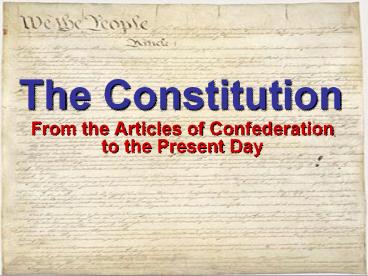The Constitution - PowerPoint PPT Presentation
Title:
The Constitution
Description:
The Constitution From the Articles of Confederation to the Present Day Weaknesses of the Articles 1. Could not levy taxes or regulate commerce 2. – PowerPoint PPT presentation
Number of Views:228
Avg rating:3.0/5.0
Title: The Constitution
1
The Constitution
- From the Articles of Confederation to the Present
Day
2
Weaknesses of the Articles
- 1. Could not levy taxes or regulate commerce
- 2. Sovereignty, independence retained by states
- 3. One vote in Congress for each state
- 4. Nine of thirteen votes in Congress required
for any measure - 5. Delegates to Congress chosen paid by state
legislatures - 6. Little money coined by Congress
- 7. Army small and dependent on independent state
militias - 8. Territorial disputes between states led to
open hostilities - 9. No national judicial system
- 10. All thirteen states consent necessary for
any amendments
3
Plans of Government
Characteristic Virginia Plan New Jersey Plan
Legislature Two chambers One chamber
Legislative power Derived from the people Derived from the states
Executive Unspecified size More than one person
Decision rule Majority Extraordinary majority
State laws Legislature can override National law is supreme
Executive removal By Congress By a majority of the states
Courts National judiciary No provision for national judiciary
Ratification By the people By the states
4
Compromise
- The CT Compromise
- Bicameral legislature
- House of Representatives based on proportional
representation - Senate based on equal representation
- Additional Compromise
- Three-fifths compromise
- Commerce and slave trade
- Electoral college and presidential terms
5
Preamble Six goals
- Form a more perfect Union
- Establish justice
- ensure domestic tranquility
- Provide for the common defense
- Promote the general Welfare
- Secure the blessings of liberty
6
Basic Principles
- Popular Sovereignty
- Federalism
- Separation of Powers
- Checks and Balances
- Judicial Review
- Limited Government
7
The Articles
- the legislative powers
- the executive powers
- the judiciary
- federalism/relations between states
- amendment process
- Supremacy and responsibility
- ratification process
8
- I. The Legislative Branch
- A. The powers granted Congress are expressed in
Article I, Section 8. - Delegated Powers
- B. Powers denied in Article I, Section 9
- Right of habeas corpus -- No bill of attainder
- No ex post facto law -- Titles of nobility
- Tax Export -- tax states unequally (voided by
16th AMD) - II. The Executive Branch
- A. The Founders recognized the need for a strong
executive and granted the president broad but
vaguely described powers. - B. Article II, Sections 2 and 3 describe the
specific powers of the president. - III. The Judicial Branch
- A. Two levels of courts, federal and state, each
with its own jurisdiction - B. Supreme Court exercises important power by
using judicial review. - IV. Shared Power and Conflict
- A. The executive and legislative branches must
cooperate to produce effective policies - the expansion of presidential power has caused
conflicts - C. The Supreme Court must depend on the
president and the executive branch to carry out
its decisions. - Congress has the power to limit judicial
authority
9
(No Transcript)
10
(No Transcript)
11
- Amendments
12
(No Transcript)
13
(No Transcript)
14
From Confederation to Constitution
Under Articles of Confederation Under Federal Constitution
A loose confederation of states A firm union of people
1 vote in Congress for each state 2 votes in Senate for each state representation by population in House (see Art. I, Secs. II, III)
2/3 vote (9 states) in Congress for all important measures Simple majority vote in Congress, subject to presidential veto (see Art. I, Sec. VII, para. 2)
Laws executed by committees of Congress Laws executed by powerful president (see Art. II, Secs. II, III)
No congressional power over commerce Congress to regulate both foreign and interstate commerce (see Art. I, Sec. VIII, para. 3)
No congressional power to levy taxes Extensive power in Congress to levy taxes (see Art. I, Secs. VIII, para. 1)
No federal courts Federal courts, capped by Supreme Court (see Art. III)
Unanimity of states for amendment Amendment less difficult (see Art. V)
No authority to act directly upon individuals and no power to coerce states Ample power to enforce laws by coercion of individuals and to some extent of states































